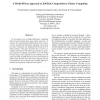Free Online Productivity Tools
i2Speak
i2Symbol
i2OCR
iTex2Img
iWeb2Print
iWeb2Shot
i2Type
iPdf2Split
iPdf2Merge
i2Bopomofo
i2Arabic
i2Style
i2Image
i2PDF
iLatex2Rtf
Sci2ools
IPPS
2007
IEEE
2007
IEEE
A Model-Driven Approach to Job/Task Composition in Cluster Computing
In the general area of high-performance computing, object-oriented methods have gone largely unnoticed. In contrast, the Computational Neighborhood (CN), a framework for parallel and distributed computing with a focus on cluster computing, was designed from ground up to be object-oriented. This paper describes how we have successfully used UML in the following model-driven, generative approach to job/task composition in CN. We model CN jobs using activity diagrams in any modeling tool with support for XMI, an XML-based external representation of UML models. We then export the activity diagrams and use our XSLT-based tool to transform the resulting XMI representation to CN job/task composition descriptors.
Activity Diagrams | CN Jobs | Distributed And Parallel Computing | IPPS 2007 | Job/task Composition |
| Added | 03 Jun 2010 |
| Updated | 03 Jun 2010 |
| Type | Conference |
| Year | 2007 |
| Where | IPPS |
| Authors | Neeraj Mehta, Yogesh Kanitkar, Konstantin Läufer, George K. Thiruvathukal |
Comments (0)

